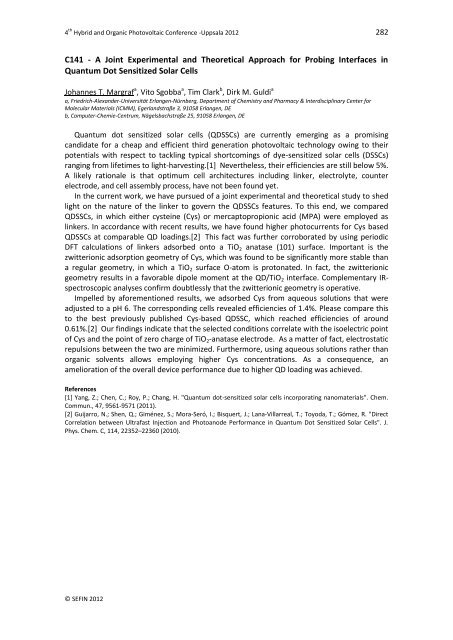HOPV12 - Blogs
HOPV12 - Blogs
HOPV12 - Blogs
Create successful ePaper yourself
Turn your PDF publications into a flip-book with our unique Google optimized e-Paper software.
4 th Hybrid and Organic Photovoltaic Conference -Uppsala 2012 282<br />
C141 - A Joint Experimental and Theoretical Approach for Probing Interfaces in<br />
Quantum Dot Sensitized Solar Cells<br />
Johannes T. Margraf a , Vito Sgobba a , Tim Clark b , Dirk M. Guldi a<br />
a, Friedrich-Alexander-Universität Erlangen-Nürnberg, Department of Chemistry and Pharmacy & Interdisciplinary Center for<br />
Molecular Materials (ICMM), Egerlandstraße 3, 91058 Erlangen, DE<br />
b, Computer-Chemie-Centrum, Nägelsbachstraße 25, 91058 Erlangen, DE<br />
Quantum dot sensitized solar cells (QDSSCs) are currently emerging as a promising<br />
candidate for a cheap and efficient third generation photovoltaic technology owing to their<br />
potentials with respect to tackling typical shortcomings of dye-sensitized solar cells (DSSCs)<br />
ranging from lifetimes to light-harvesting.[1] Nevertheless, their efficiencies are still below 5%.<br />
A likely rationale is that optimum cell architectures including linker, electrolyte, counter<br />
electrode, and cell assembly process, have not been found yet.<br />
In the current work, we have pursued of a joint experimental and theoretical study to shed<br />
light on the nature of the linker to govern the QDSSCs features. To this end, we compared<br />
QDSSCs, in which either cysteine (Cys) or mercaptopropionic acid (MPA) were employed as<br />
linkers. In accordance with recent results, we have found higher photocurrents for Cys based<br />
QDSSCs at comparable QD loadings.[2] This fact was further corroborated by using periodic<br />
DFT calculations of linkers adsorbed onto a TiO2 anatase (101) surface. Important is the<br />
zwitterionic adsorption geometry of Cys, which was found to be significantly more stable than<br />
a regular geometry, in which a TiO2 surface O-atom is protonated. In fact, the zwitterionic<br />
geometry results in a favorable dipole moment at the QD/TiO2 interface. Complementary IRspectroscopic<br />
analyses confirm doubtlessly that the zwitterionic geometry is operative.<br />
Impelled by aforementioned results, we adsorbed Cys from aqueous solutions that were<br />
adjusted to a pH 6. The corresponding cells revealed efficiencies of 1.4%. Please compare this<br />
to the best previously published Cys-based QDSSC, which reached efficiencies of around<br />
0.61%.[2] Our findings indicate that the selected conditions correlate with the isoelectric point<br />
of Cys and the point of zero charge of TiO2-anatase electrode. As a matter of fact, electrostatic<br />
repulsions between the two are minimized. Furthermore, using aqueous solutions rather than<br />
organic solvents allows employing higher Cys concentrations. As a consequence, an<br />
amelioration of the overall device performance due to higher QD loading was achieved.<br />
References<br />
[1] Yang, Z.; Chen, C.; Roy, P.; Chang, H. "Quantum dot-sensitized solar cells incorporating nanomaterials". Chem.<br />
Commun., 47, 9561-9571 (2011).<br />
[2] Guijarro, N.; Shen, Q.; Giménez, S.; Mora-Seró, I.; Bisquert, J.; Lana-Villarreal, T.; Toyoda, T.; Gómez, R. "Direct<br />
Correlation between Ultrafast Injection and Photoanode Performance in Quantum Dot Sensitized Solar Cells". J.<br />
Phys. Chem. C, 114, 22352–22360 (2010).<br />
© SEFIN 2012


